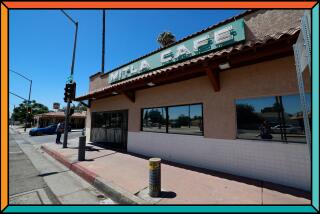Battling Over the Future of L.A.’s Historic Olvera Street
- Share via
As president of the Olvera Street Merchants’ Assn. I am sorry to say that I agree with Frank del Olmo’s article regarding Olvera Street (Op-Ed, Dec. 20). When pondering the lackluster of Olvera Street today, one must examine just what has led it to this poor and somewhat desperate condition.
When the street opened in 1930, it was a labor of love by Christine Sterling, supported by the private sector with cooperation from government. It had finally been transformed from an old dirty alley, to a living, vital memorial to the city’s Spanish and Mexican heritage.
In 1953 Sterling thought the area would be best protected as a state park and so the state, county and city each bought a piece of the Pueblo for $250,000 from the individual property owners. It then received its designation as a historic landmark.
Many different types of management then followed, including a time when designated merchants ran the operation. Nonprofit corporations, county, state and city all tried their hand at operating the Pueblo until the present-day managers, the city’s Department of Recreation and Parks. Most merchants agree that they have spent more in legal fees over the past 10 years just to keep their businesses in the family than ever before. All this in spite of Sterling’s promise of longevity to the pioneer families of the street. It was soon realized that the government did not have a feeling for the area or Sterling’s gentle hand that old-time merchants had been accustomed to.
In 1963, at Sterling’s opting, a committee of long-term family merchants were named the Olvera Street Merchants’ Assn.
Between the mid-1970s through to the present time, with the loss of the grand Madrina, Olvera Street had changed, the power of government had taken hold of the very life and breath of the street. The association challenged the park administration in areas such as daily maintenance, insufficient lighting, expensive parking rates, unsupervised security and a general lack of visitor accommodations. The rights of the merchants and the traditions that had been maintained by the old families were being uprooted. Business had fallen drastically.
Due to the difficulties brought on by poor management the retail merchandise had deteriorated. The best customers were now the schoolchildren on their field trips with an average of $5 to spend. If it weren’t for them, many merchants would have closed up shop some time ago. Even the cultural events like Cinco de Mayo had lost their charm. Originally a tribute to the famous battle at Puebla, it is now a beer-drinking, sponsor-advertising mania with no fiesta unless it falls on a weekend when big dollars can be made. While merchants object strongly, we have no say in these matters. All these decisions are made at a higher level.
We did something to change all this. We spent more than $100,000 to provide the city with a plan of rejuvenation and restoration to bring back the culture and heritage. We sincerely want to preserve and revive whatever still remains of the early days. We cannot do it all ourselves, but we must be an integral part of the revitalization. Without the merchants there is no link to the past. Include us not as a token, or the minority quota that must be met, but as active, enthusiastic participants who will help shape the future from the past.
We invite the City Council and the mayor to meet us half-way.
VIVIEN CONSUELO BONZO
Olvera Street Merchants’ Assn.
Los Angeles
More to Read
Sign up for Essential California
The most important California stories and recommendations in your inbox every morning.
You may occasionally receive promotional content from the Los Angeles Times.













